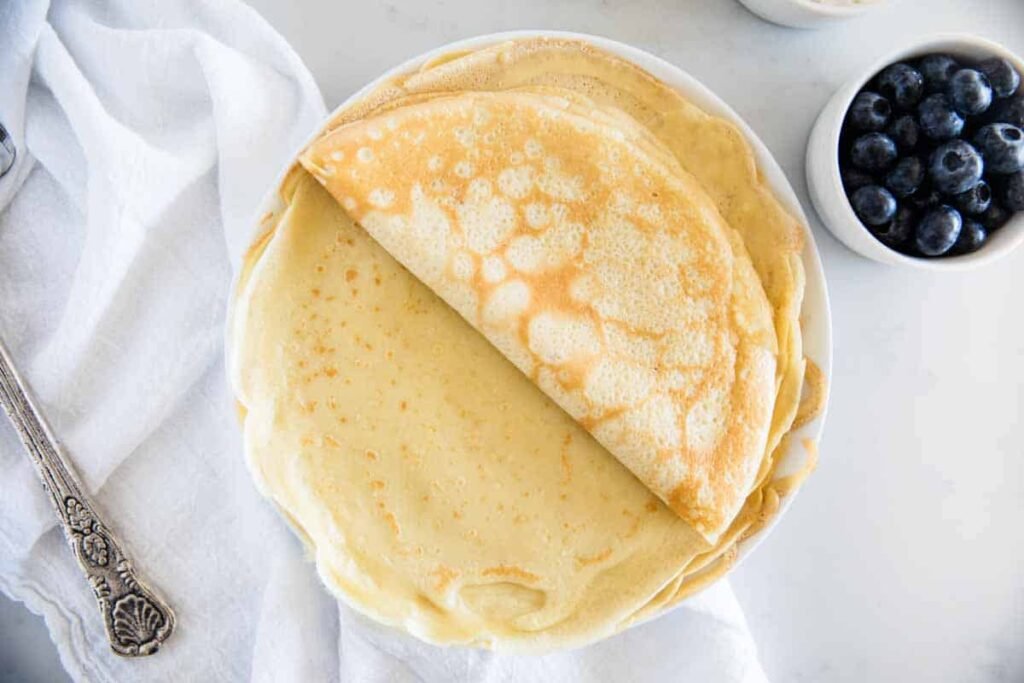The smell of butter in a pan reminds me of my grandmother’s kitchen in Tuscany. As a kid, I’d watch her make thin pancakes that seemed to float. Those moments sparked my love for Italian crespelle, and I’m excited to share it with you today.
Crespelle are Italy’s version of French crepes. They’re thin pancakes for both savory and sweet dishes. Whether you’re a pro chef or just starting, learning to make Italian crespelle opens up new culinary adventures.
In this guide, we’ll explore making these thin pancakes. We’ll look at their history and how versatile they are. You’ll learn how to make crespelle that would impress any Italian nonna.
Ready to improve your cooking with an authentic Italian crespelle recipe? Let’s start a delicious journey through Italian cuisine, one thin crespelle at a time.
Introduction to Italian Crespelle: A Thin Pancake Delight
Italian cuisine is full of tasty treats, and crespelle are a standout. These thin pancakes have won the hearts of many in Italy and worldwide.
What Are Crespelle?
Crespelle are thin, delicate Italian pancakes, like French crepes. They’re made with flour, eggs, and milk. You can enjoy them savory or sweet, making them great for any meal.
The Origins of Crespelle in Italian Cuisine
Crespelle have a long history in Italy. They started in Tuscany and spread to other parts of the country. Each region made its own version, adding to their charm.
Crespelle vs. French Crepes: Similarities and Differences
Crespelle and French crepes are similar but different. Crespelle are a bit thicker and often baked. French crepes are thinner and served with toppings. Both are known for their light texture and versatility.
“Crespelle are the canvas of Italian cuisine, allowing chefs to paint with flavors from savory to sweet.”
Enjoying a crespelle filled with cheese and spinach or a sweet one with Nutella is a taste of Italy. Crespelle’s beauty is in their simplicity and the endless ways to use them in cooking.
Essential Ingredients for Authentic Crespelle Batter
To make the perfect crespelle batter, you need the right ingredients. Start with all-purpose flour for structure and texture. Eggs are key for binding and adding richness and color.
Milk is important for the batter’s consistency. Whole milk gives a creamy texture. Low-fat milk is a lighter option that still tastes great.
A pinch of salt boosts the flavor. A bit of melted butter prevents sticking and adds richness. Some recipes add sugar, even for savory crespelle, to enhance taste and browning.
Italian crespelle can vary by region. In Tuscany, chestnut flour adds a nutty taste. Northern Italy’s recipes often include herbs like rosemary or sage for extra flavor.
The secret to perfect crespelle lies in the quality of your ingredients and the balance of your batter.
Try different flour mixes or add-ins to make your own crespelle batter. Aim for a smooth, thin batter. This will give you delicate, lacy crespelle perfect for filling.
Step-by-Step Italian Crespelle Recipe
Making perfect Italian crespelle needs focus and practice. This guide will show you how to make this delicate treat.
Preparing the Batter
Begin by mixing flour, eggs, milk, and a bit of salt. Make sure it’s smooth and without lumps. Adding melted butter or olive oil can add flavor.
Resting the Batter: A Crucial Step
Let the batter rest for at least 30 minutes. This makes the crespelle light and tender. Use this time to get your fillings ready.
Cooking Techniques for Perfect Crespelle
Warm a non-stick pan over medium heat. Pour a small amount of batter and spread it evenly. Cook until the edges lift, then flip and cook for a bit more. These steps help you get thin, golden crespelle.
Troubleshooting Common Crespelle Issues
If crespelle are too thick, add a bit of milk. For tears or holes, adjust the pan’s heat or use less batter. Remember, making crespelle gets better with practice.
“The secret to perfect crespelle lies in the balance of ingredients and the finesse of your cooking technique.”

Savory and Sweet Crespelle Fillings to Try
Crespelle are great for both savory and sweet dishes. Italian recipes have many tasty options. Let’s explore some delicious ideas for your next crespelle dish.
For savory crespelle, try ricotta and spinach. Sauté fresh spinach with garlic, then mix it with creamy ricotta. Sprinkle with Parmigiano-Reggiano for extra flavor.
Prosciutto and mozzarella are another favorite. Top it with balsamic glaze for a burst of taste.
Seafood fans will love shrimp and scallops in tomato sauce. Vegetarians can enjoy roasted zucchini, eggplant, and bell peppers.
Sweet crespelle are just as tempting. Try Nutella and bananas for a quick dessert. Or, go for sweetened ricotta and candied fruits for a traditional treat.
A lemon and sugar filling adds a zesty twist. It’s perfect for a refreshing dessert.
“Crespelle are like a canvas. The fillings you choose paint the flavor story.”
Don’t forget, the best fillings come from your creativity. Mix your favorite Italian ingredients to create unique flavors.
Regional Variations of Italian Crespelle
Italy’s diverse culinary landscape offers a rich tapestry of regional crespelle specialties. As you explore the country, you’ll encounter authentic Italian crespelle variations that reflect local traditions and ingredients.
Tuscan Crespelle Specialties
In Tuscany, crespelle often take center stage in hearty dishes. You might savor crespelle alla fiorentina, delicate crepes filled with ricotta and spinach, then baked in a creamy bechamel sauce. This comforting dish showcases the region’s love for simple yet flavorful ingredients.
Northern Italian Crespelle Traditions
Northern Italy brings its own twist to crespelle. In Lombardy, you’ll find crespelle con funghi porcini, where the crepes are stuffed with earthy porcini mushrooms and Parmigiano-Reggiano cheese. These regional crespelle specialties often feature richer, cream-based sauces that warm you up during colder months.
Southern Italian Crespelle Innovations
Southern Italy’s crespelle embrace the region’s vibrant flavors. In Naples, try crespelle al limone, zesty lemon-infused crepes often served as a refreshing dessert. Sicily offers its own authentic Italian crespelle variations, like crespelle alla siciliana, filled with sweet ricotta and candied fruits, showcasing the island’s Arabic influences.
“Every region in Italy has its own crespelle story to tell, each one more delicious than the last.”
From north to south, Italian crespelle adapt to local tastes, creating a diverse array of dishes that celebrate regional culinary heritage. These variations offer a delightful journey through Italy’s gastronomic landscape, inviting you to explore the country one crespelle at a time.
Related Italian Recipes
Italian cuisine is full of delights beyond crespelle. You’ll find many italian recipes that show the country’s love for thin, delicate creations. Cannelloni is a close cousin to crespelle. These pasta tubes are filled with savory ingredients and baked in sauce, much like stuffed crespelle.

Try manicotti for a twist on traditional pasta. This italian pancake dish is similar to cannelloni but uses a thicker pasta shell. It’s often filled with ricotta and spinach, then baked in tomato sauce. If you’re craving something lighter, piadina might be your new favorite. This flatbread from Emilia-Romagna is perfect for wrapping around cured meats and cheeses.
Don’t forget about savory pies like torta pasqualina. This Ligurian Easter specialty features layers of thin pastry filled with greens, cheese, and eggs. It’s a testament to Italy’s mastery of thin, layered dishes. For dessert lovers, crostata is a must-try. This rustic tart showcases Italy’s knack for turning simple ingredients into something extraordinary.
Exploring these italian recipes will deepen your appreciation for the country’s culinary traditions. Each dish tells a story of regional flavors and time-honored techniques, much like the beloved crespelle.
Conclusion
Learning how to make Italian crespelle opens up a world of flavors. These thin pancakes are perfect for both sweet and savory dishes. With the right ingredients and techniques, you can make delicious crespelle every time.
Patience is important when making the batter and cooking these pancakes. Letting the flour soak up the liquid makes them smooth and easy to fold. As you get better, you’ll know when they’re just right.
Feel free to try different fillings. You can go for classic Italian flavors or try something new. Crespelle are great for lunch, dinner, or dessert. They’re sure to wow your guests.
Now you have all you need to make delicious Italian crespelle at home. So, get your pan ready, mix the batter, and start your crespelle journey. Buon appetito!
FAQ
What are the main ingredients needed for crespelle batter?
To make crespelle batter, you need flour, eggs, milk, and sometimes salt. You can also add sugar, vanilla, or lemon zest for extra flavor.
How do crespelle differ from French crepes?
Crespelle and French crepes are similar but different. Crespelle have a simpler batter without butter or sugar. They’re often used in savory dishes, unlike French crepes, which are sweet.
What is the proper technique for cooking crespelle?
To cook crespelle right, use a small amount of batter in a hot pan. Cook each side until golden. It’s important to control the heat and swirl the batter well.
What are some popular savory fillings for crespelle?
Savory fillings for crespelle include ricotta, spinach, mushrooms, and prosciutto. You can also use meat or vegetable sauces. Some places add pumpkin, sausage, or truffles for a twist.
How do I prevent crespelle from sticking or tearing?
To stop crespelle from sticking, grease the pan well and keep the heat low. Let the batter rest for 30 minutes before cooking. Use a spatula to gently loosen the edges when flipping.
What are some regional variations of crespelle in Italy?
In Tuscany, crespelle are filled with spinach and ricotta. Northern Italy, like Emilia-Romagna, uses meat ragù or pumpkin. Southern Italy goes for seafood or vegetable sauces.
Can crespelle be made ahead of time?
Yes, you can cook crespelle ahead and store them in the fridge or freezer. Just stack them with parchment paper and reheat or fill them when you’re ready.

